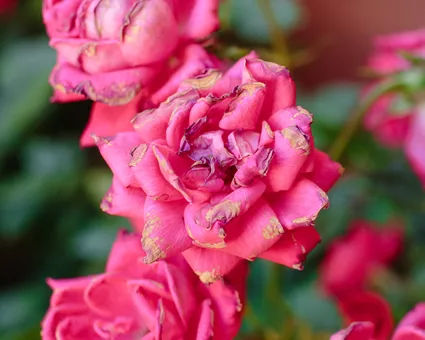Keeping Away Black Spot Disease on Beautiful Roses at Home, Here’s How

Black Spot Disease on Beautiful Roses – Photo by Pinterest
(Istimewa)Adding nature to liven up homes can be done by adding ornamental plants. Be it foliage or flowers, plants are proven to improve moods. In recent times where people spend most of their time indoors at home, trends of ornamental plants are on the rise. Take roses, for instance, planting colorful and fragrant roses brings a beautiful freshness to a garden or room. But taking care of ornamental plants has its own sets of challenges. One thing to be aware of is the black spots that can show up on the leaves of roses and other ornamental plants. These black spots can reduce the beauty and threaten the overall health of the plants.
Black spots on roses are caused by a fungus called Diplocarpon rosae. While the name might make it seem like the fungus is a threat singularly to roses, it can attack any plant with fleshy leaves and stems/canes. The black spot disease attacks the plant during humid and moist weather where the leaves are wet for 7 or more hours. The fungus can thrive during this humid weather and are more of a threat to plants. Especially for younger plants that are more susceptible to diseases.
Symptoms of black spots on rose plants
Black spot disease is a common and most serious disease that threatens roses. While it does not kill the rose directly, infected roses can become stressed, weak, and vulnerable to other diseases and pests. Symptoms to be aware of for the infected rose plants are as follows.
- The first symptoms of the disease come in the form of black or purplish irregular round spots on the topside of leaves.
- Symptoms will show on the lowest part of the leaves first. As it worsens, it will move up and the infected leaves will drop to the ground.
- Yellowing around the dark spots that spread around the leaf tissues and often the leaf will drop.
- Small black spots can also appear on young canes.
How to control it
Left untreated the disease can affect the rose’s growth by reducing the number or lessen the quality of the flower. With that in mind, quick action needs to be done to reduce the effects of the disease. The first step is to get rid of the fungus in the rose plant is by removing the infected leaves and canes. The infected needs to be disposed of away from the plants and sprayed with a fungicide. This ensures that the fungus is terminated and doesn’t infect other growing plants.
While there is no cure for the infected plants other than removing them, black spots disease can be prevented by giving the plant ideal growing conditions. Here are a few prevention tips for healthy roses.
- Good exposure to the sun. Roses prefer a sunny location with all-day sun. Plant roses in a place that have good exposure to the morning sun. It can help to dry moisture from the leaves.
- Good airflow. Good circulation helps the air to get through the plant. If the plant gets too dense, prune the spaces between canes. It ensures that there are no conditions where moisture can build up, while the spaces between canes make it harder for the black spots to spread.
- Pruning and cleanup. As said before, removing the infected leaves and canes can prevent the disease from spreading further. Prune infected leaves and stems in dry weather. The spores are spread by water, pruning in dry weather reduces the chance of further spreading. Afterward, the infected can be disposed of and the tools disinfected.
- Proper watering and drainage. Avoid overhead watering and getting the leaves wet. Instead, focus the water directly on the plant’s root. Rainwater is unavoidable, but having proper drainage ensures that there are no water puddles where fungus and other diseases can cultivate.
- Natural fungicide. The black spots can be persistent and stay in the soil despite continuous pruning. When needed, the use of organic fungicide such as sulfur can be sprayed lightly as a preventive and controlling measure.
Fertilizer recommendations for roses
Proper and regular fertilization is an important element when planting roses. It is considered a heavy feeder flower that needs macronutrients such as nitrogen, phosphorus, and potassium. Nitrogen encourages healthy leaf growth, and since a rose’s ability in producing flowers resides in its leaf, Healthy foliage will result in more flowers. Phosphorus promotes healthy root development and flower production. Lack of phosphorus can mean unopened buds and weak flower stems. And potassium keeps the plant healthy by helping it recover when it is stressed by insects or diseases. Other than these macronutrients, roses also need micronutrients including calcium, magnesium, iron, and zinc.
Both organic or inorganic fertilizers can be used for roses. If using inorganic fertilizer such as the NPK Pelangi, there are special rose plant foods with a higher phosphorus ratio or use a general-complete fertilizer with a ratio of 5-10-5 or 4-8-4. Organic fertilizer typically has a slower nutrient release but leaves fewer residues on the soil. Composted manure is a great alternative to the chemical NPK source for roses. Just make sure that the manure is aged and not fresh. The high nitrogen content on fresh manure can burn the plants.
Another tip when applying fertilizer on roses is to water before and after. Watering before fertilizer prevents root burn or shock while watering after application helps deliver nutrients more efficiently and helps the roots better absorb the nutrients.
